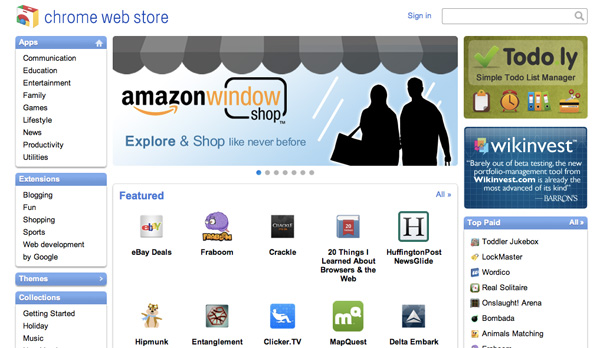Anand's Thoughts on Google's Chrome OS
by Anand Lal Shimpi on December 8, 2010 6:23 PM ESTApps
Google’s Chrome web store is already fully functional and works with existing installations of the Chrome browser on Windows or Mac platforms. Chrome OS notebooks will run the very same apps.
These are web based apps however they can support an offline mode, choosing to sync data when an internet connection becomes available again. As I mentioned earlier, Google imposes stipulations on what can be published to the Chrome web store. The limitations are as follows:
Applications may not contain sexually explicit material, depict violent or bullying behavior, hate speech, impersonation or deceptive behavior, unauthorized publishing of personal and confidential information (no Wikileaks Chrome app I guess), infringe on intellectual property rights of others, engage in illegal activities, facilitate online gambling, contain malicious products (e.g. viruses, malware), violate third party terms of service or enable unauthorized download of streaming content or media. The full list is pretty well defined and there’s nothing too unusual.
Google, like most platform owners, is simply trying to keep the web store clean, legal and devoid of any harmful software.

Since these are all web based apps, you can not only sync your apps across multiple systems but all of your data within the apps. It’s currently all tied together using your Google account, so any Chrome notebook or Chrome browser instance that you give your Google account information to will have an up-to-date list of your apps, extensions and settings. Removing an app on one Chrome platform will remove it from all, automatically.
Document and data syncing should also seamless as everything is stored in the cloud. You ultimately have to entrust Google with everything but for those who feel comfortable doing so or who already do, it’s a definite benefit of the platform. By contrast, syncing applications and data across multiple PCs or Macs isn’t nearly as easy or as free.










104 Comments
View All Comments
tipoo - Wednesday, December 8, 2010 - link
Yeah, its just a prototype to test the OS but I really wish manufacturers used this kind of design more often! No logos, no curves, no patters, no glossy black plastic, nothing but what matters.tipoo - Wednesday, December 8, 2010 - link
*patternsyzkbug - Wednesday, December 8, 2010 - link
Looks like a lot of us here share the same vision of how notebooks should be designed. Here is an idea. Let’s start an open-hardware project (analogous to an open-source project) defining what our notebook should be (high quality LCD, no 16:9 screen, no gloss, thin bezel, no-flex keyboard, etc.) May be one day, a notebook manufacturer will hear us and turn it into a real product. Anand, do you want to drive this? ;)Dug - Thursday, December 9, 2010 - link
Hear hear!It seems so obvious, but good ol stupid marketing and project managers can't get it through their thick heads to listen to customers.
vol7ron - Tuesday, December 14, 2010 - link
Perhaps your wants aren't what the majority of people want; and since price is based off supply, demand, and cost, perhaps they really don't want to lose.When you start specializing, you lose an economy to scale. There are higher manufacturing costs, which means it'd cost more for the rest of the people, which equals less sales, which equals less profits. This is one of the reasons why the Dell manufacturing process was so successful; they used only a couple of base models so that prices would not be as high.
But I agree, having some variance in design would be nice. I would not call it "open-hardware", I'd call it "open-design", which could encompass hardware as well as software.
Computer Bottleneck - Thursday, December 9, 2010 - link
I like that idea, but what platform/OS would that go best with?mrBug - Sunday, December 12, 2010 - link
AROS !!!!!!!!!!!!!!gr00 - Friday, January 14, 2011 - link
I wouldn't call it open hardware because open-source hardware already exists, more like "sensible notebook design initiative". Definitely agree on "no 16:9 screen, no gloss", many of those are just standards that I hope will come to pass.GullLars - Thursday, December 9, 2010 - link
I liked the design, with exception of connectivity options (seriously 1 USB, and no external storage?), but the name is not thought through.The reference platform is called Cr-48, which is a very unstable radioactive isotope (λ < 24 hours) of the element Chrome (nr 24 in the periodic table)... Cr-52 is the most abuntant stable isotope, and would make a better name for a computer...
tipoo - Thursday, December 9, 2010 - link
Nah. This is a public beta of sorts, its going to be buggy. Naming it after the stable molecule of Chrome would ruin its name, naming it after an unstable isotope with a short half-life makes sense for this :)